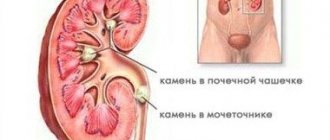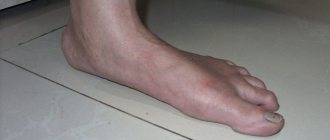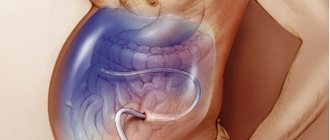What is creatinine
Creatinine is the end product of the breakdown of creatine phosphate, which is involved in the energy metabolism of muscle and other tissues. It is formed in the muscles, then released into the blood, and excreted from the body through the kidneys and urine. Creatinine is a nitrogenous slag, and with increased levels in the blood, it has a toxic effect on organs and systems.
In a healthy person, its concentration in the blood is constant and practically does not change throughout the day. The level of creatinine depends on the rate of formation in the muscles and excretion by the kidneys. When the filtering function of the kidneys is impaired, creatinine in the urine decreases and its level in the blood increases.
Why do they take a creatinine test before a CT scan?
Examination is recommended for patients before CT with contrast. Contrast involves that before scanning, a special iodine-containing drug is injected into the patient's brachial vein using an injector. It is distributed throughout the circulatory system, “staining” soft tissues and vessel walls on scans (CT angiography), thus increasing the information content of the study.
Contrast is not always performed, but only in cases where it is necessary to examine blood vessels or check organs and soft tissues for damage and tumors, especially oncological ones. The effectiveness of CT with contrast in this case is based on the fact that in places where malignant tumors are localized, the blood supply differs from normal: it is more or, conversely, less intense. Malignant neoplasms appear to be the site of abnormal (pathological) accumulation of the contrast agent, and are more clearly visualized on CT scans.
After the examination, the iodine-containing drug is excreted from the body through urine naturally. Our center uses Omnipaque contrast from the group of the safest non-ionic drugs.
The contrast is excreted from the body by the kidneys within 1-2 days. A laboratory biochemical blood test for creatinine (“Rehberg test” or “serum creatinine”) is necessary in order to exclude kidney pathologies, or more precisely, impaired excretory function.
What does creatinine show and who is prescribed the test?
The results of determining the level of creatinine in the blood are used to diagnose diseases of the cardiovascular, digestive, endocrine, and nervous systems, the severity of the pathology, and the effectiveness of treatment.
A biochemical blood test for creatinine is prescribed to assess the excretory function of the kidneys.
Signs of impaired filtration and secretion of the kidneys:
- swelling of the face and legs;
- increase in abdominal volume;
- decrease in the volume of urine excreted;
- pain in the lower back, under the ribs along the spine;
- discomfort when urinating;
- dark colored urine with blood clots;
- high blood pressure.
Damage to kidney tissue and intoxication of the body with nitrogenous wastes is indicated by muscle weakness, fatigue, dizziness, loss of appetite, drowsiness, and absent-mindedness.
Determination of creatinine in the blood is a mandatory test before planned and emergency surgery, MRI and CT with contrast, in case of extensive burns and injuries with a large percentage of muscle damage.
A creatinine test is performed for patients with diseases that are accompanied by impaired renal function:
- arterial hypertension,
- renal failure,
- dermatomyositis,
- systemic lupus erythematosus,
- diabetes mellitus,
- jade,
- heart failure,
- glomerulonephritis.
Assessment of the level of creatinine in the blood is included in the complex of screening examinations during pregnancy.
The analysis has no contraindications or restrictions.
Complexes with this research
Entry into IVF Examination when a woman enters the IVF procedure 13,590 ₽ Composition
Fitness control of sports nutrition Assessment of liver function, hormone levels and metabolism when taking sports nutrition 2,780 ₽ Composition
Kidney screening Screening for kidney dysfunction 660 RUR Composition
IN OTHER COMPLEXES
- Biochemistry of blood. 8 indicators 990 ₽
- Healthy interest RUB 2,140
- Nutritionist recommends RUB 4,190
- Expanded hospital complex RUB 4,150
- Female infertility RUB 9,210
Preparing for analysis
The biomaterial for research is venous blood serum. The procedure is preferably performed in the morning on an empty stomach.
To make the analysis informative, you must follow the rules for preparing for the delivery of biomaterial:
- Maintain 8-12 hours of fasting. There are no restrictions on the use of still water.
- During the day, control the amount of protein food.
- Two days before the test, do not consume fatty foods, coffee, or alcohol.
- The day before, do not overload the body physically, limit stress factors, visit the sauna, bathhouse.
- Refrain from smoking for 30–40 minutes before the test.
Some medications affect creatinine levels, so it is important to tell your doctor about the medications you are taking 7 to 10 days in advance. If necessary, they will be temporarily canceled.
Important!
If other therapeutic procedures are planned on the same day as the analysis, they are performed after donating blood.
The analysis results are ready the next day, in emergency cases - in an hour. The study of creatinine levels is included in the biochemical analysis of blood, urine, and the Rehberg test, which is more informative for assessing kidney function.
Interpretation of results
Reference values are determined by age, gender, muscle mass and body type. In women and asthenics, the concentration of creatinine in the blood is lower than in men and hypersthenics.
In healthy women over 20 years of age, the normal concentration of creatinine in the blood is 50-98 micromol/l, in men - 64-111 micromol/l. With age after 60 years, the amount of creatinine increases slightly, and is several micromoles above the upper limit of normal.
Children have lower creatinine concentrations:
- from birth to one year - 15–37 µmol/l;
- from one to 5 years – 21–42 µmol/l;
- from 5 to 10 years - 28–65 µmol/l;
- from 10 to 15 years - 34–77 µmol/l;
- from 15 to 20 years - 51–92 µmol/l.
For physiological reasons, the creatinine content in the blood is slightly higher or lower than normal. The stronger the deviation, the more severe the pathological process.
Reasons for deviations from the norm
A physiological change in indicators occurs when protein foods predominate in the diet, during periods of stress, and after intense physical activity. The results are also affected by certain medications, pregnancy, and well-developed muscle mass.
High creatinine
A false increase in creatinine levels can be caused by taking certain antibacterial, anti-inflammatory, diuretic drugs, steroid hormones, aspirin, fructose, and glucose.
Causes of pathological increase in creatinine levels:
- renal failure,
- urolithiasis disease,
- diabetes,
- hypertonic disease,
- glomerulonephritis,
- autoimmune diseases;
- leukemia,
- prostatitis,
- atherosclerosis,
- dermatomyositis.
Extensive injuries, burns, inflammation of muscle tissue, dehydration, benign tumors of the thymus gland, and malignant neoplasms increase the creatinine content.
Increased creatinine in the blood occurs during gastrointestinal bleeding, intestinal obstruction, heart failure, myocardial infarction, myocarditis.
In the third trimester, excess of the upper limit of normal occurs due to compression of the kidneys by the fetus and insufficient blood supply to them.
Low creatinine
Diseases associated with impaired synthesis of antidiuretic hormone - muscular dystrophy, anorexia, cachexia, diabetes insipidus - reduce the level of creatinine in the blood. The reasons for insufficient creatinine levels are amputation of limbs, hemodialysis (extrarenal blood purification), and a deficiency of protein products in the diet.
During pregnancy, especially in the first and second trimester, blood volume and glomerular filtration increase, respectively, the amount of creatinine in the blood decreases.
Elevated creatinine levels
When assessing creatinine metabolism, most often one has to deal with an increase in the concentration of this metabolite. It is very important to correctly interpret the obtained indicators, taking into account the possibility of physiological and pathological increases, age and gender standards. The condition in which an increase in plasma creatinine is recorded is called hypercreatinemia.
Hypercreatininemia does not cause severe abnormalities in the body, since creatinine itself is low-toxic. Its harmful effects on tissue can only appear with sharp deviations from the norm in its concentration. This metabolite is more related to the consequences of various conditions and diseases, signaling their presence. Therefore, isolated hypercreatininemia causes virtually no symptoms.
It is usually combined with other pathological symptoms that may suggest the need for this study:
- Muscle pain;
- Fatigue and muscle weakness;
- Edema;
- An increase or sharp decrease in the amount of daily urine;
- Pathological changes in general urine analysis (protein, leukocytes, erythrocytes).
The pathogenesis of hypercreatinemia can be associated with any of the stages of creatinine metabolism and circulation in the body. It can be influenced by the nature of the diet, the mode of physical activity, the amount of fluid consumed, the use of medications, the anatomical features of muscle tissue and its condition, the functional abilities of the excretory system and liver.
What does elevated creatinine mean?
An increase in creatinine concentration during a biochemical blood test may indicate:
- Increased intake of creatine-containing substances into the body from the environment with increased protein nutrition;
- Excessive or very rapid increase in muscle mass;
- High loads performed by muscles;
- Destruction of muscle tissue;
- Redistribution of blood and disruption of water balance in the body;
- Impaired kidney function in neutralizing and excreting creatinine;
- Toxic effects on the body;
- Endocrine disorders that regulate metabolic processes in the body.
In some cases, one has to deal with a relative increase in creatinine levels, which does not occur due to its excess production or retention in the body. It is associated with a decrease in the volume of circulating plasma as a result of its redistribution, blood loss or dehydration. Relative hypercreatininemia is combined with other signs of hemoconcentration and blood thickening, which helps in its correct assessment. It never reaches large values.
An increase in creatinine levels can be physiological, not due to disease, or pathological. In the second case, the main cause of hypercreatinemia is renal failure in any type of kidney damage, in which creatinine numbers can increase several times. Physiological hypercreatinemia can never be represented by a large deviation from the norm!
Causes of elevated creatinine
The immediate causes of hypercreatinemia, taking into account the severity of the increase in creatinine, are presented in the table.
| Pathological causes of increased creatinine | Physiological reasons for increased creatinine | |
| Moderate hypercreatinemia | Severe hypercreatinemia | |
|
|
|
How to reduce creatinine in the blood?
After a detailed examination and clarification of the cause of hypercreatinemia, the following recommendations can be given:
- Hospitalization in medical institutions according to the profile in case of detection of diseases. These may be general therapeutic hospitals and specialized departments for the treatment of renal or other types of pathology;
- Taking medications to normalize protein metabolism and remove toxic products of protein metabolism;
- Normalization of water metabolism by selecting optimal volumes of fluid consumed for a particular case, taking into account the capabilities of the kidneys. If hypercreatinemia is caused by physiological mechanisms, then an increase in the daily volume of pure high-quality water will lead to a decrease in the concentration of creatinine and will accelerate its excretion by the kidneys;
- Normalization of diet in qualitative and quantitative terms. It involves the complete exclusion or limitation of the consumption of protein foods and salt, which contribute to an increase in nitrogen compounds or retain fluid in tissues. This, in addition to the absolute increase in creatinine, causes its relative increase due to hemoconcentration;
- Correction of lifestyle and physical activity. They must be brought into line with the actual capabilities of the body. If no pathological causes of increased creatinine have been identified and the only option for this condition is excessive physical activity, they should be reduced as much as possible;
- Extracorporeal detoxification procedures (hemodialysis and its analogues). The use of an artificial kidney is advisable only for severe types of hypercreatinemia caused by decompensated renal pathology or intoxication.
Under no circumstances should you even try to cope with elevated creatinine levels in the blood on your own. This symptom may be the small tip of a large iceberg of illness. Any corrective and therapeutic measures must be supervised by a specialist!
Diet for high creatinine
One of the most important measures to reduce creatinine levels is diet therapy. Its general characteristics include limiting the consumption of protein foods, salt and potassium, enriching the diet with antioxidants and foods that cleanse the body.
Excluded:
- Fatty varieties of animal and poultry meat (pork, duck, goose);
- Fatty fish;
- Whole milk;
- Spicy dishes and spices;
- Coffee and strong tea;
- Dishes made from rich yeast dough;
- Fried foods and smoked meats.
Limited to:
- Dietary meats (chicken, rabbit, turkey, young beef). You can introduce meat days twice a week, when they are included in small quantities in dishes;
- Eggs – up to 2-3 per week;
- Fish. Fish days are organized by analogy with meat days;
- Salt and sugar. With a pronounced increase in creatinine, they are completely excluded;
Recommended:
- Fresh or boiled vegetables and fruits in any quantity;
- Berries, fruit drinks and compotes based on them;
- Nuts and dried fruits. They are limited or completely eliminated only in case of renal failure, when the potassium level is sharply increased;
- Fermented milk products (yogurt, kefir, fermented baked milk);
- Cheese and cottage cheese;
- Butter and vegetable oil;
- Cereals and porridges based on them. Rice is especially useful in this regard;
- Wholemeal bread with added bran and pasta;
- Honey;
- Mineral and purified plain water at least one liter per day. Water loads are minimized only in cases of renal failure.
- Allowed dishes:
- Boiled;
- Steamed;
- Stewed;
- In the form of soup, puree, cream soup, salad, jelly, porridge, casseroles, cutlets, meatballs;
Additional important recommendations: scientific arguments
- Reduce your consumption of red meat.
Research shows that eating large amounts of red meat may increase creatinine levels, at least temporarily. If you eat a lot of red meat, switch to vegetable dishes [1].
- More fiber.
Eating more fiber-rich foods can also help reduce creatinine. For example, a 2014 study published in the European Journal of Clinical Nutrition found a significant reduction in creatinine levels in 143 participants with chronic kidney disease who increased their dietary fiber intake [2]. (on the topic: fiber: benefits, types + TOP products).
- Additives with chitosan.
A 2011 study published in the Journal of Pharmacy and Pharmacology examined the effects of chitosan on 80 patients with kidney failure. Half of the patients were given chitosan three times daily in tablet form, which resulted in a significant reduction in creatinine levels after 4 weeks compared to control patients [3].








